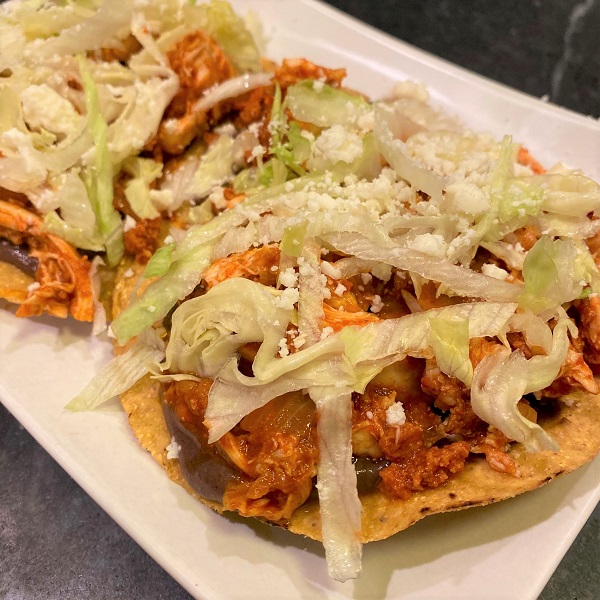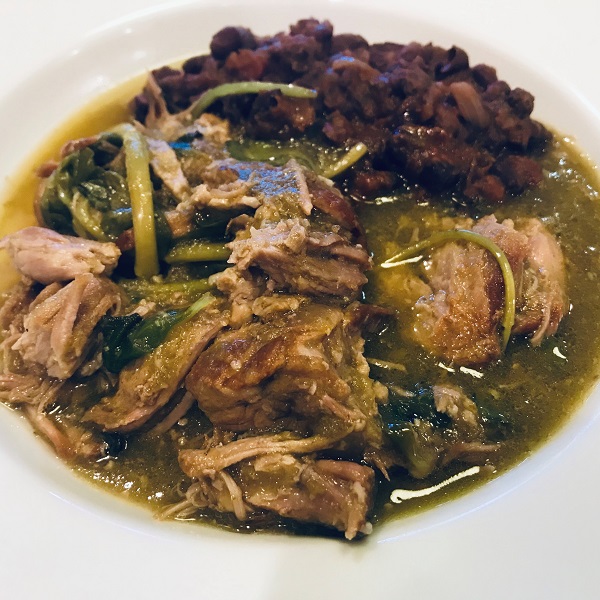 https://www.gastro-curious.com/wp-content/uploads/IMG_2867.jpg
600
600
Jamie Kelly
https://www.gastro-curious.com/wp-content/uploads/gastro-curious-340.png
Jamie Kelly2020-03-25 14:51:442022-07-11 14:55:49Tinga de Pollo Tostadas
https://www.gastro-curious.com/wp-content/uploads/IMG_2867.jpg
600
600
Jamie Kelly
https://www.gastro-curious.com/wp-content/uploads/gastro-curious-340.png
Jamie Kelly2020-03-25 14:51:442022-07-11 14:55:49Tinga de Pollo TostadasEssentials • Small Bites • Soups/Stews • Salads • Entrees • Sauces • Desserts • Beverages • All Recipes
The Latest
Street food dictates the joy of my eating life. Going to the bank (Quesadillas de marlin), Spanish class (tacos de quesobirria), driving to La Paz (bacon wrapped bean and cheese burritos). Each task has it’s own associated delicacy making the errand so much more delightful!
#comidamexicana #exploresabor #bajacaliforniasur #todossantosbcs #lavidachoyera #quesobirria
Do you ever just need a quick bite to keep going? Tacos de canasta (from the basket) are made for just such an emergency. Conveniently located, well…everywhere, you can quickly snatch a few of these moist morsels of chorizo, chicarron, potato, bean and more. Made in the wee hours of the day, these tacos are kept in a steamy bed, wrapped in always blue plastic within a basket and generally transported by bicycle. After an educational morning at the Museo de Intervenciones in Churubusco, a vendor strategically placed outside saved me from the pangs of hunger. With a classic Mexican Coca Cola in glass bottle, one cannot go wrong.
#tacosdecanasta #churubusco #cdmxlife #exploresabor #mexicancocacola
Most foreigners have heard the term “cantina” but few know the magic of this humble establishment throughout Mexico. There are high-end and hipster variations, but the true cantina is a little-embellished dive bar.
Once upon a time, cantinas held a strict men only admission policy. Inside men drank, enjoyed free food—from peanuts to guisados—and played card games or dominoes. Little has changed in the cantinas of CDMX except that now I don’t need a Y chromosome to enter.
I stopped by La Potosina in El Centro with friends to partake of the cantina culture one afternoon. While the humble appearance betrays nothing, this is no average cantina. Founded in the 1890, it is considered among the oldest cantinas in Mexico. An illustrious list of past clients includes Fidel Castro, el Che Guevara, Pancho Villa, and Emilio Zapata. Today, La Potosina is often packed for soccer matches on TV. The owners, the Solórzano family, are huge fans of the Atlante team, earning the cantina a nickname “Cueva del Potro”, cave of the Potros de Hierro, as the players are called.
The day of my visit, the cantina was relatively quiet with just a few tables of patrons and several obvious regulars at the bar. A shoeshine professional entered from the bustling street, put his portable buffing box on the floor and bellied up to the bar where he was met with salutations as if he had just arrived home for the day. Owner, Roberto Solórzano, stood behind the bar and the young cook sat on the patron side, playing a game of dominos.
The bar is amply stocked with staple spirits and domestic beer. The three of us took two rounds of Negra Modelos while snacking on Spanish peanuts. We shared a plate of the day’s nosh: pork and potatoes stewed in a spicy salsa verde and finished up with a round of mezcal. Grand total: $500 pesos (roughly $25 USD).
If you’re looking for Mixology, head to Fifty Mils in the Four Season, but if you want a classic cantina vibe wherein you’ll be welcomed ANY DAY FROM 10am to 12am (yes, you read that right) and leave satisfied at a better than fair price, you won’t be disappointed by La Potosina.
#cantinasdemexico #cdmxlife #elcentrocdmx #lapotosina #mezcal
Juice is life in Mexico. In a country where potable water can be less abundant than fruits and vegetables, juice concoctions remain an all-day national favorite despite the deep reach of soda companies. Mixed juices, licuados (think smoothies), and aguas frescas (infusions) come in every color of the rainbow and are loaded with energy-inducing sugar and nutrients.
A perfect example of a CDMX juice vendor is Jugos y Licuados Rosales in Iztapalapa. The small store front is overflowing with fruit and veggies waiting to meet their tumultuous end in the blender or juicer. Everything is prepare to order. I opted for a thick and rich mamey licuado, made from a type of sapote fruit not easily found at home. Fortunately, it is almost never too late to get your nutrition at Jugos y Licuados Rosales as the shop is open until 11 PM!
#licuados #mameysapote #iztapalapa #exploresabor #cdmxlife
Ahhhh pulque. How I love your odd, ancient, mildly intoxicating ways. Though fermented maguey sap may not immediately appeal to all, I am proof that this refreshing, milky, slightly viscous drink can be acquired.
I’m a fan of natural or “blanco” pulque’s sour, yeasty taste, but innumerable sweet and savory options abound. I visited the iconic Los Hombres sin Miedo (The men without fear) pulquería in Iztacalco. Since 1895, bartenders here no have dipped into pulque barrels to serve thirsty souls traveling along Calzada de la Viga back when the route into El Centro was still an active waterway. Shallow chalupa boats carried flowers and other products to market from Xochimilco’s rich chinampas fields. The pulquería in those days had two sides separating their cuatomers by gender.
Today, the establishment has an aesthetic of sanitary simplicity. No nonsense, monochromatic tile covers the walls, floor and ceiling. A sparse collection of lightly varnished tables and chairs are scattered across the large room. The only natural light comes through narrow slits at the top of the walls which display a few cherished items including a signed photo of the legendary actor Pedro Infante.
I was treated to a pulque blanco ($35 pesos) by a local aficionado, Mario, who opted for the piñon (pine nut) flavor ($70 pesos). Both were served in a two hands-required liter glass. Despite the pale pink hue, the piñón (pine nut) pulque not too sweetly delivered the subtle flavor of christmas spices. I was delighted to learn that one can control the sweetness of flavored pulques by ordering a “campechano” (mixture-$50 pesos). To test the theory, we ordered a blanco-piñon campechano to go! It came in a bag with quick-sip technology that came in handy on our 8-peso packed minibus back to Iztapalapa where the pink potion was heartily received—mostly intact—by Señora Flor and Señor Cesareo.
Fun fact: The bar’s name harkens back to when bullfighting was not legal in the Capitol. The Pulquería’s owner abuelo Andres organized clandestine fights for only the bravest men, likely emboldened by pulque!
#pulque #loshombressinmiedo #iztacalco
Before boarding a chalupa in Xochimilco, I found a dockside torta de tamal vendor. While it might seem carb overkill to wrap a corn tamal in a bolillo, at least I didn’t compound the effect with a tall, hot cup of champurrado (a beverage thickened with corn flour or masa). That is the calorie-rich customary breakfast for many laborers in CDMX, for good reason!
#tortadetamal #xochimilco
A few months ago, I read that the gorgeous spires of white flowers that grow on yucca plants are eaten in some regions of Mexico but the season for the “flor de izote” was yet to come. So, when visiting the home of friends in Hidalgo which happened to have a fresh bloom on a giant yucca, I couldn’t resist. Señora Florentina had never prepared the flowers but knew of the dish and was game to try. We harvested the 2 pound stalk of buds and set about separating all the leaves. Uncooked they taste like green peas with a slight bitter note. Our preparation was the simplest option, sautéed in butter with white onion, salt and pepper. The result, wrapped in fresh corn tortillas, was unique and delicious. I can’t wait to try other preparations!
#comidamexicana #explore sabor #flordeizote #flordeyucca
To eat like a local in CDMX, start the day with homemade quesadillas (champiñones, huitlacoche, rajas con queso, and quelites). These are best if made with love by a Mexican abuela. Follow up with a quick market snack of in-season tuna (fruit of nopales) at Mercado de la Sector Popular. For the main event, head to Del Valle for pozole de puerco at El Meson de Valencia with owners Guillermo and Delia. The restaurant is a very popular classic fonda with daily specials and a well-known pozole. There is a secret ingredient in there that I have yet to pinpoint but that only begs another visit.
#comidamexicana #pozole #tunadenopal
People talk about “street food” but let’s not forget the highway classics all across Mexico! Today’s CDMX-Tlaxcala-Hidalgo round trip included a pitstop for esquites and pasties. Yes, Uppers of Michigan, pasties are a thing from a long history of mining in Mexico too!
#esquites #roadtrip #comidamexicana #pasties
In my experience, Chilangos are expert road trippers and have staked out the best places to eat at every turn. Today’s trip from Iztapalapa through Texcoco, into Tlaxcala and to the little town of Santa Barbara in Hidalgo. The first stop of the day was in Calpulalpan for Barbacoa. The place was small and unmarked but filled with people-in-the-know. I ordered two costilla (ribs) tacos and a large bowl of consumé. But thanks to my host, Señor Cesario, I learned of the incredibly delicious pancita verde and had to have one in the name if research. Having made pancita (stomach stuffed with organ meats and regional secrets), I’m well acquainted with the dish but, ufff, this one was extraordinary!
#barbacoa #hidalgomexico #pancitaverde #calpulalpan #tlaxcala



